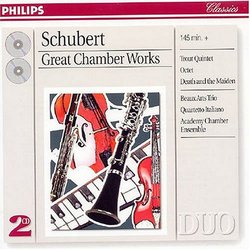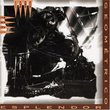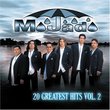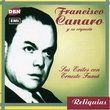| All Artists: Franz Schubert, Beaux Arts Trio, Samuel Rhodes, Georg Maximilian Hortnagel, Academy of Saint Martin in the Fields Chamber Ensemble, Quartetto Italiano Title: Schubert: Great Chamber Works Members Wishing: 0 Total Copies: 0 Label: Philips Import Original Release Date: 1/1/2004 Re-Release Date: 4/16/2004 Album Type: Import Genre: Classical Styles: Opera & Classical Vocal, Chamber Music Number of Discs: 2 SwapaCD Credits: 2 UPC: 028947543923 |
Search - Franz Schubert, Beaux Arts Trio, Samuel Rhodes :: Schubert: Great Chamber Works
 | Franz Schubert, Beaux Arts Trio, Samuel Rhodes Schubert: Great Chamber Works Genre: Classical
|
Larger Image |
CD DetailsSimilar CDs
|
CD ReviewsA convenient collection of good to excellent readings of 3 c Discophage | France | 12/15/2006 (4 out of 5 stars) "Philips has brought together on the twofer from their mid-price "Duo" series good to excellent interpretations of three of Schubert's chamber music masterpieces : the "Death & the Maiden" string quartet recorded by the Quartetto Italiano in 1965, the "Trout" Quintet by the augmented Beaux-Arts trio, made in 1975 (shortly after the recording by Gilels and the Amadeus Quartet for DG - see my review of Schubert: Trout Quintet, Death and the Maiden / Amadeus Quartet) and the string and wind Octet by the Academy of Saint-Martin in the Fields Chamber Ensemble, their first recording from 1977 (the made another one ten years later, for Chandos, albeit with only three members from the earlier ensemble). The beautiful Notturno, in the 1966 and first recording by the Beaux-Arts trio, serves as a lagniappe (it is also available on another fine "Duo", in a collection of Schubert's complete trios: Franz Schubert: Complete Trios).
Of the three, the Academy's Octet is the best and remains, to this day, one of the best versions on modern instruments, and in my opinion much better than the Academy's Chandos remake (see my lengthy reviews of both under their respective full-price, original CD release: Octet, D.803 and Schubert: Octet in F major, D. 803). It is brisk and lively in the fast movements and highlighted by the fine instrumental colors of the winds, slow and meditative in the sublime "Adagio" (2nd movement) where Antony Pay's clarinet produces exquisitely hushed pianissimos. Its only (and not minor, in my opinion) flaw resides in the ensemble's unfortunate choice not to do the variations' repeats in the 4th movement (these repeats always have an architectural importance in Schubert's variation movements), added to the generally slow tempos and somewhat fussy phrasings adopted therein. Still, its availability on this favorably-priced twofer is very welcome, as the original CD issue had become difficult to find. The Philips catalog is graced with many fine versions of the "Trout" Quintet, including Brendel's two recordings (Schubert: Piano Quintet in A, "Trout" Op. 114 D. 667 and Schubert: Trout quintet/Mozart: Piano Quartet In G Minor), and my personal favorite, with Ingrid Haebler and Arthur Grumiaux from 1966 (now on Belart Mozart: Quintet in A; Schubert: Quintet in A D667, Op114). I've also reviewed the present recording by the Beaux Arts Trio, augmented of violist Samuel Rhodes and bassist Georg Hörtnagel, under its original CD release (paired with Beethoven's "Ghost" trio (Schubert: Quintet in A D667, Op114; Beethoven: Trios Op70). It is now also available on a Pentatone SACD, with the not very coherent coupling of a Mozart clarinet quintet played by the Grumiaux Quintet from 1974 (Schubert: "Trout" Quintet, D667; Mozart: Clarinet Quintet, KV581 [Hybrid SACD]). It is very good, expansive but muscular in the outer movements, forward-moving and almost sprightly in the "Andante" second movement. Violinist Isidore Cohen plays with warmth and charm, but Bernard Greenhouse has a slightly dry cello tonal production from the cello and Menahem Pressler's piano placement is slightly too forward and overbearing. The Quartetto Italiano's reading of the "Death & the Maiden" is a classic. It is controlled and disciplined - maybe a little too much so - with great attention to architectural coherence and tempo consistency as well as to Schubert's myriad details of articulation and phrasings. Tempos are moderate, and the tension the Italianos elicit comes not from raging fury, as with ensembles such as the Capet Quartet in 1928, the Amadeus Quartet's first recording from 1953, the Emerson or Petersen Quartets among modern recordings, but from articulation and phrasings that are vigorous yet never at the expense of clarity and bounce. Their interpretation may be a little short on the sense of fury and despair that the above-mentioned recordings can produce, but it has something of a classic poise. Still, Philip's inclusion of it on this twofer was not necessarily the best choice, as it shows a disputable propensity to milk the cow: it is indeed, by my count, the 4th mid-price CD reissue of that classic recordings (search "Quartetto Italiano Schubert" for the others), which appears on another very desirable twofer from the Duo series with the ensemble's recordings of Schubert's late quartets, that the Schubert or Quartetto Italiano aficionado is likely to have. And that choice of Philips is all the more regrettable as the Italians' later, 1982 recording of "Death and the Maiden", in the ensemble's short-lived lineup with Dino Asciola replacing Elise Pegreffi as 2nd fiddler, is still, to the best of my knowledge, unreissued on CD. " |

 Track Listings (13) - Disc #1
Track Listings (13) - Disc #1



